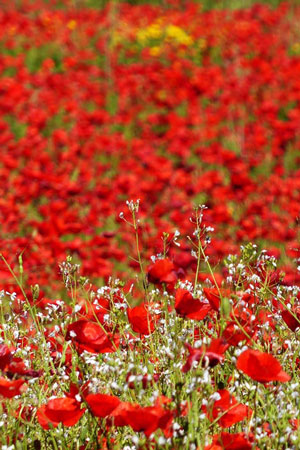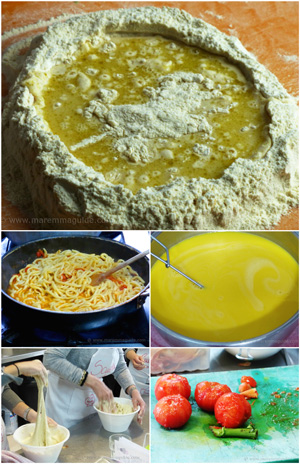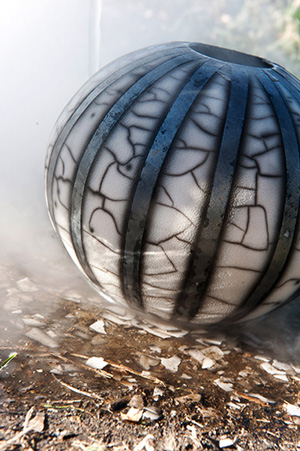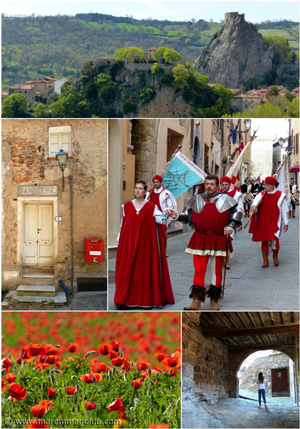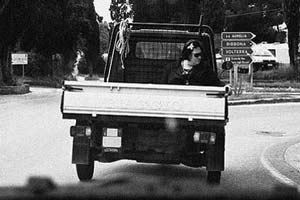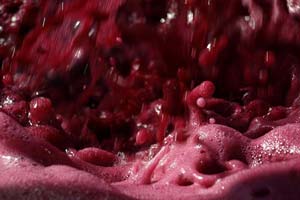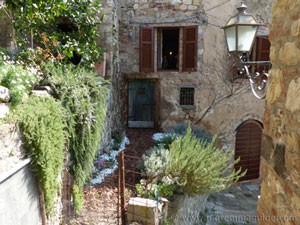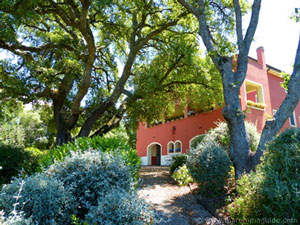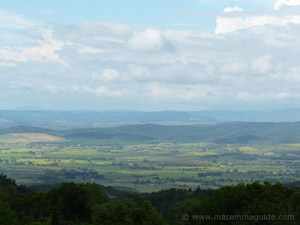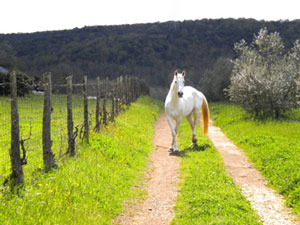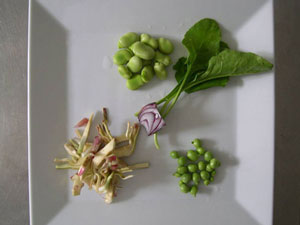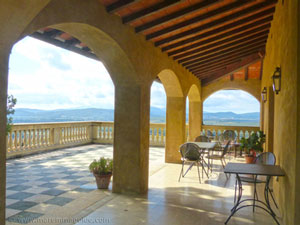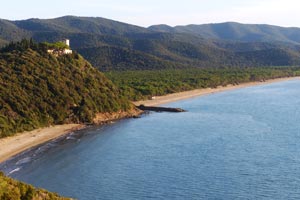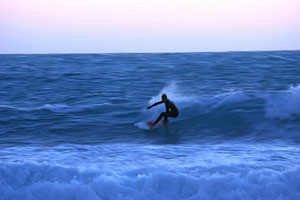The hidden crypt of Abbazia di San Salvatore di Giugnano in Maremma
Visit the hidden Abbazia di San Salvatore di Giugnano and its crypt before it is gone. For this special archaeological site that dates back to the Viking age more than one thousand one hundred years ago is fast crumbling and will sadly be gone. Probably in less time than it takes for my young daughter to want to take her children to see it. Crumbling as the forces of nature, a nearby river, and an earlier attempt to halt its degradation, take their weighty toll.
The abbey isn't the most awe inspiring ruin you will ever see - there just isn't much left. And its crypt isn't by any means the most beautiful crypt in Italy, nor in Tuscany. It is all of a few square metres and with just four columns. But when you first glimpse it, it will take your breath away. Because even though you have gone to see it and you know that it is underground, nothing really prepares you for when you come across that hole in the mound of earth under the canopy of Holm oaks. And its subterranean treasure.
For those four columns and their capitals aren't just any four columns and capitals.
The sparsity of documentary records means that the chronological history of the Abbazia di San Salvatore di Giugnano isn't a clear trail to follow and is consequently full of hypotheses and conjecture. But what we do know is that the site was first occupied by a church with a small community gathered around it, and that it rose to be an influential and very wealthy Benedictine monastery. At the start of its fall it became a site of organised labour, was devastated by the unimaginable pain and suffering of two years of famine, and then wiped out by the Black Death that followed here in Maremma. Abandoned and sold. (You can find out more below.)
If you are as captured by its mysteries and existence as those who descend the ladder into its history are, spread the word to your friends and family, to those you know in business, to everyone, in the hope that someone who reads about it can help with the funding needed to protect it for many years to come.
The underground Romanesque crypt - La cripta romanica di Giugnano

The first sight and the going down to explore are the best bits for children.
Important warning to parents.
Don't let your little ones - or even the not so little - in your family go off hunting for the entrance to the underground Crypt of Giugnano ahead of you: the (in my humble opinion, weak as water) wire net fencing around the hole has been trodden down and there is nothing to stop you falling directly in.
I know I have said it before in other pages, that I worry too much, but forewarned is forearmed.
The crypt is, without doubt, the oldest surviving part of the monastery.
In all probability it was built at the same time as the very first structures of the abbey in the first years of the eleventh century. But there is the possibility that it was once below that of the original church.
Getting down into the crypt
There are two ways in.
The first is the ladder in the hole you first see. Which is the way I went trembling down: I don't like heights or ladders! I know you are thinking, "it isn't that far down into the crypt!". But when you put your first foot on the top rung and head down backwards, it feels like a long way down!

Or, as my friend did, via the "back door" - but actually the original door into the crypt - that I hadn't spotted. It is a muddier route, and you will need someone to give you a hand up for the last part out, but it avoids the backwarsd down a hole fear of heights problem.
 The "back door" way in, originally the main entrance.
The "back door" way in, originally the main entrance.

The roof of the entrance on the way down.

The view on the way out.

The floor of the crypt today is about three metres underground. Once inside there is no artificial lighting, so you will have to wait for the rays of sunshine that penetrate the leaf canopy overhead to light-up parts of the room and its details. But when they do it is a special sight.
The column with the "Corinzo" - Corinthian - capital.

The "cubico" -cubic - capital.

The column with the "Ionico" capital and behind it the original entrance door to the crypt.


The taurine head on the Corinthian capital.

The crumbling centre of the vaulted roof.

The column with the Corinthian capital.

Giugnano crypt's eastern wall: a large apse divided into three naves supported by four columns.

The columns with the Corinthian (in the foreground) and "ionico" capital (to the right) and the three naves.

What is intriguing is that the crypt has windows that today are filled with earth. But at one time they must have let in light from an above ground structure. Today, rainwater drains through them carrying silt onto the floor of the crypt.

All four of the crypt's columns.

The columns with the cubic (foreground) and Corinthian (background) capitals.

Take a another look...
And whilst the youngest of any children in your group will by now have had the look around that interests them, any budding architectural historians amongst them will have spotted that the crypts four columns are all different. That is, the two to the east are octagonal in shape and built of limestone. The two to the west are round and are of rhyolite.
Limestone isn't a local stone to the area and they could well have come from an even earlier prestigious villa nearby. One hypothesis is that they are from the ancient Poggiarello villa.
And then the really interesting bit for those who love the unravelling of times past and what a decoration here and an engraving there can add up to...
For the decoration of the column's capitals is in three styles. Two or leaf forms of early Corinthian period, one of ionic scrolls, and the fourth of a somewhat out of place cubic design. Together with the crypts floor plan they add up to place the construction and decoration of Giugnano's crypt in the 11th century, at a time of architectural experimentation. When sculptors had the freedom to interpret old forms in new shapes.
The "cubic" geometric capital is noticeably different for another reason: for it has a square base that doesn't sit well on its column. One conjecture is that the vertical spaces held dowels that in turn held a coloured cloth decoration.
Indeed, the capital carvings in trachyte - the local rock around Roccastrada (there is even a trachyte trekking trail from the monastery site) - are considered to be the highest level of medieval stone carving in that material that has come to light to date.
These were no ordinary stonemasons. And so the mystery continues. Where did stone carvers with those skill sets come from?
The traces of plaster work on the crypt's western wall were probably covered in frescoes.
The video
Take a walk around the crypt.
What is left of the Abbey of San Salvatore in Giugnano
OK, whilst I'm not advocating that you pack hard hats to visit - although the Health and Safety responsibility I had in a previous life would say that you should! - do be aware that the walls are crumbling and that the ground on which they were built over one thousand one hundred years ago is being undermined by the local river - the Torrente Bai - and is giving way too.
The rubble and cut stones in a roughly two hundred metre or so circle around the entrance to the crypt tell tale of a large structure above - possibly the original Benedictine church - the light from inside of which would have lit the crypt below.
What you can see today a few metres to the east are the north and part of the eastern external walls of an abbey that once extended across 3,000 square metres. Considered by some to be a "new" 13th century building - maybe even built because the original monastery building at the site of the crypt was already in ruin.
Around which were minor religious and residential buildings that completed the complex.


The Gothic window.

One of the two remaining walls.


The riches to ruin story:
the rise and fall of the Abbazia di San Salvatore di Giugnano
The following detective story has been traced and pieced together by hours and hours of collaborative study, patience and hunting in archives by archaeologists, art historians and architects specialising in restorations.
I find the whole thing fascinating; from the slight change in spellings of place names to the breaks in the trail that leave chasms for conjecture and hypothesis. Mysteries are a wonderful thing.
The tentative trail of the earliest records
The earliest surviving documents about the site are those dated the years 867 and 868, which refer to a "casale" - house. They were found in the diplomatic archives of the abbey of the Abbazia del San Salvatore in Monte Amiata and are a communication between one Count Winigi of Siena with the four sons of a deceased aristocrat Petrone from Chiusi, about the land around the house of Titinanus and Iunianu.
The next is a leap forward of 145 years to the year 1012. It tells of a population gathered around a church of considerable possessions called San. Stefano located in, "in loco et finibus Iungano".
Fifteen years later in 1027, Conrad II, in his first year as Emperor of the Holy Roman Empire, gives the, "ecclesiam Sancti Stephani in Iuniano" to the Abbot of the monastery of San. Salvatore in Monte Amiata in Maremma.
Those three pieces of the detective story aren't considered to be firm ground as it isn't possible to be sure, without a doubt, that they don't in fact refer to another location in Maremma.
But there is a strong architectural link between the structure of the crypt of the Monte Amiata abbey - dated to the first years of the 11th century - and that of Giugnano probably built just a few decades later, which would support the existence of a relationship between the two.
The monastery is there without a doubt
But without a doubt, in the 11th century there is a Benedictine monastery on the site.
The first surviving document found to date about which there is no doubt that it refers to the monastery at Giugnano is dated September of 1075 (or 1076). It is a deed gifting the abbey and other properties owned by Count Aldobrandesco Ildebrando (V) and his wife, the Countess Lulitta, to the Church of S. Andrea of nearby Montemassi. The monastery then is known as the, "monasterio de Gungnano".
In just a few years it becomes an especially noteworthy and important economic site. Evidence of part of its capital possessions were found in a dedication and privilege issued by Pope Innocenzo II on 18 April 1140, in favour of the Abbot, Benedetto, of the monastery of Sancti Salvatoris de Juniano. He gave the monastery a lot of properties and churches. The result of which was that the monastery now had properties concentrated in three particularly strategic areas: along the last stretch of the Ombrone river, near Grosseto. In the region immediately to the north and east of Giungnano, around Roccastrada and Roselle. And in the middle of the valley of the Ombrone, including Gello, Grosseto, Litaino, Montecodani, Monteverdi, Pignese, Torri and more.
At the beginning of the year 1200, the Abbazia di San Salvatore di Giugnano controlled three flour mills, an iron foundry (smelting iron-ore from the Island of Elba which had insufficient locations with rivers and had already burnt all of its timber - Maremma's metalliferous hills had lots of both), and sulphur works, all located along the valley of the Bai river whose course today now undermines its structure. As well as silver and copper mines.
The hydraulic power of the Bai river had been used since Roman times along this stretch: it's torrential nature is constant throughout the year, even in the height of summer. You'll hear its waters gushing when you get out of your car. Walk the few metres down the road and you can play very fast Poo sticks :)
A chasm and a new mystery
After that the events of the Abbey during the 12th century remain a mystery. What is likely is a period of crisis during the spiritual reforms of the second half of that century.
Passed from pillar to post and blight
And it was at this time, in 1207 and in 1208, that Popes Innocent III and Honourius IV conferred the Abbazia di San Salvatore di Giugnano and its titles and deeds to the Cisternian monastery of San Galgano at Monte Siepi in Tuscany. Expanding their properties and control all the way through Maremma to the sea and the River Ombrone. Including the all important City of Grosseto salt flats.
In whose hands it was downgraded to a grange: a monastic structure built founded on organised labour and concentrating on grain. As the Abbot of San Galgano similarly did with other properties it had gained within the Grosseto territory.
Whether or not as part of the Abbey of San Galgano's slimming down as part of its financial and land crisis around 1270, in 1288 Giugnano abbey was again passed around: this time to the joint ownership of the Agnostinian monks of San. Lucia di Val di Rosia in Sovicille, Chiusdino, whose Prior could turn water into wine (just thought I would mention it!). And those of San. Antonio di Ardenghesca at Casale di Pari. The Abbazia di San Salvatore di Giugnano has lost much of its importance. The once dense industrial activities around it now only comprised of one mill and the iron works.
The majority of the local population, as mosts of their counterparts in Tuscany, have moved to live close to the fortifications and castled residences that were built on Maremma's hills tops between the end of the 11th and the beginning of the 13th centuries.
The Agnostinian monks did nothing to maintain the abbey at Giugnano and it fell into rack and ruin.
The final straw
Then, the worst famine to hit Tuscany in the 14th century (it was hit hard by many) came in 1328 and lasted for two years.
The living souls that remained were then wiped out by the Black Death that swept across Maremma in 1357.
What those of you who have stumbled across this page and are new to Maremma won't know is that Maremma was already infamous as a land rife with malaria; death at an early age - we are talking average life expectancies of twenty years - was commonplace.
The abandoned Abbey of San Salvatore at Giugnano was put up for sale on 21 October 1357.
Intense mining in the area by the Republic of Siena in the 14th century all but obliterated any trace of those medieval buildings together with a systematic demolition and reuse of the building materials.
From that point on, clearly in an already ruinous state, it is all but lost from documentary records.
In 1612, the official documentary accounts of the properties of the area by the town of Roccastrada only list the one surviving mill and the iron works.
In 1775, when required to list and name all crumbling and deserted ecclesiastical sites within their diocese, the priors of Maremma were able to recount the ruins of an old monastery in the area, but not its name.
The mill - a fortified one - on the other hand, continued to operate until around 1940 and is now a private home.
The sad situation today
Despite searches for funding to restore/halt its decline, they haven't yet been found. Nature is moving slowly forward.
One wall of the crypt is shored-up with an iron support, rain floods in, and the nearby river is doing its bit to undermine the ground on which the abbey was built. The abbey is in a worst state than the crypt: not much is left.
But natural forces aren't the culprit of the worst of the problems.
Ironically, attempts to protect the crypt in the 1970's further aggravated it's fragile stability, when twenty-four square metres of between 30cm and more than 70 cm deep reinforced concrete were poured onto its roof. The force of its weight caused the columns to rotate, shed stone, and crushed the capitals.
Finding the Abbey of San Salvatore in Giugnano
Although the remains of the Abbey and its crypt are hidden, the route to the location is really straightforward. It is just a few metres off of the main route - the SS - between Montemassi and Roccastrada.
A note. The Abbazia di San Salvatore di Giugnano is on private land: the archaeological site is within the gardens of the Agriturismo San Guglielmo and the crypt is right next to the wall of the farmhouse.
It would be polite to first knock on the farmhouse door before visiting. Note: the wooden bench tables that you'll find in the shade of the trees - perfect for a picnic - are the owners and for their guests not us!
Directions from Massa Marittima
At the junction of the Strada Provinciale Collachia from Ribbolla with that of the Strada Provinciale Montremassi to Montemassi and Roccastrada, turn right towards Roccastrada.
At the division of the road/wide roundabout - right to Braccagni, left to Roccastrada - take the left split to Roccastrada - the SP21, also signposted to the Cripta di San Salvatore di Giugnano.
Continue for 2.5 km, past a bar to your right on a curve and take the second left exit off the main road.
It is a narrow lane that runs parallel for a short distance with the main road - signposted to the Cripta di San Salvatore di Giugnano, the Agriturismo San Guglielmo and Agriturismo Il Bettarello.
The Agriturismo San Guglielmo is the first farmhouse along the lane, about 100 metres from the turning.
For those of you who love map coordinates, those for the crypt are: 42.98531, 11.12545
Park your car along the lane just past the farmhouse. There isn't anywhere else to park.
The abbey ruin and the crypt aren't signposted. Although there is an information sign alongside the crypt when you get there.
The map
You need to walk into the copse that you can see in this photo, following the line of the old wrought-iron gate.

You'll spot the Abbey straight away on the right hand side as you enter the copse.

But the crypt is under the mound of trees that you will see on your left.

When you are leaving, the ideal place to turn your car around is about 15 metres further down the lane, just before the river crossing.
Explore some more...
